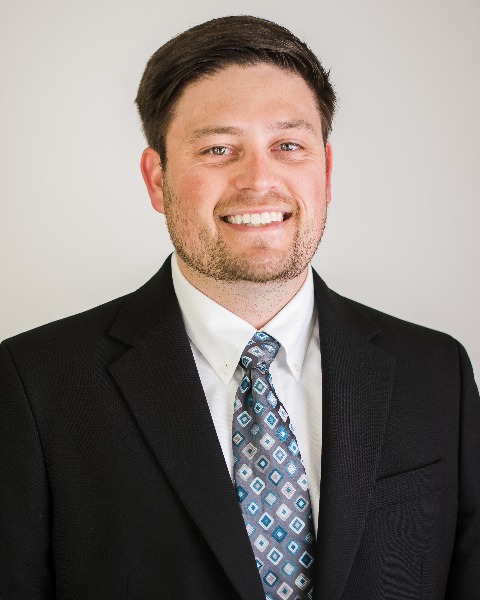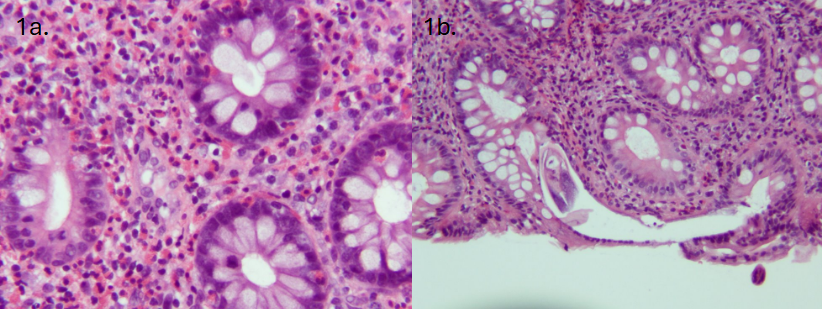Monday Poster Session
Category: Infections and Microbiome
Diffuse Eosinophilic Gastrointestinal Disease Secondary to <i>Strongyloides stercoralis</i>
P3453 - Diffuse Eosinophilic Gastrointestinal Disease Secondary to Strongyloides stercoralis
Monday, October 27, 2025
10:30 AM - 4:00 PM PDT
Location: Exhibit Hall

Tyler Ratliff, MD, MS (he/him/his)
University of Arkansas for Medical Sciences
Fayetteville, AR
Presenting Author(s)
Tyler Ratliff, MD, MS, Gregory McKenzie, MD, Bradley Hicks, MD
University of Arkansas for Medical Sciences, Fayetteville, AR
Introduction: Eosinophilic Gastrointestinal Disorders (EGIDs) are a rare, heterogenous group of diseases affecting every component of the gastrointestinal (GI) tract. The defining characteristic of non-esophageal EGIDs is abnormal eosinophilic infiltration into the luminal wall, which may occur at any layer and is varied based upon the anatomical location. Patient symptoms are highly variable and dependent on the layer of mucosal involvement. While laboratory abnormalities may raise clinical suspicion, the diagnostic evaluation should only be considered complete once endoscopy with biopsy has been performed. Herein, we present an immunocompetent patient with diffuse EGID secondary to Strongyloides stercoralis.
Case Description/
Methods: A 77-year-old male presented to clinic for follow-up evaluation following three years of diarrhea and weight loss. Patient initially underwent an EGD and colonoscopy following hospitalization for gastroenteritis that revealed mild gastropathy and mild duodenal villous blunting. Gastric biopsies revealed chronic severe gastritis and were negative for Helicobacter pylori, while colonic biopsies were normal. Stool studies at the time were unremarkable, as was imaging with CT and MRI. Despite treatment with Reglan for concerns of esophageal dysmotility and Carafate, he lost 65lbs and intermittently required parenteral nutrition. A repeat EGD and colonoscopy one year later revealed mild gastritis, but no evidence of active disease within the small bowel or colon. Biopsies during his second round of endoscopy revealed increased lamina propria eosinophils within the stomach, duodenum, and colon. Patient was placed on prednisone and colestipol, and although his weight stabilized, his diarrhea persisted with intermittent nocturnal incontinence. He then underwent a third colonoscopy, with random biopsies revealing rare parasitic microorganisms with S. stercoralis favored. He responded appropriately to Ivermectin with associated weight gain and cessation of diarrhea.
Discussion: EGIDs are rare but encompass a broad range of etiologies that must be considered during diagnostic evaluation. Approximately 60% of endoscopic evaluations reveal normal appearing mucosa, and there is no guideline-based consensus regarding the number and location of biopsies or when to consider full-thickness biopsies. Our case represents a rare cause of EGID and underscores the difficulty in determining the etiology of EGID and need for repeat endoscopic biopsies after failure of traditional treatment.

Figure: 1a. Colonic biopsy revealing extensive background eosinophilia
1b. Evidence of rare parasitic microorganisms within crypts
Disclosures:
Tyler Ratliff indicated no relevant financial relationships.
Gregory McKenzie indicated no relevant financial relationships.
Bradley Hicks indicated no relevant financial relationships.
Tyler Ratliff, MD, MS, Gregory McKenzie, MD, Bradley Hicks, MD. P3453 - Diffuse Eosinophilic Gastrointestinal Disease Secondary to <i>Strongyloides stercoralis</i>, ACG 2025 Annual Scientific Meeting Abstracts. Phoenix, AZ: American College of Gastroenterology.
University of Arkansas for Medical Sciences, Fayetteville, AR
Introduction: Eosinophilic Gastrointestinal Disorders (EGIDs) are a rare, heterogenous group of diseases affecting every component of the gastrointestinal (GI) tract. The defining characteristic of non-esophageal EGIDs is abnormal eosinophilic infiltration into the luminal wall, which may occur at any layer and is varied based upon the anatomical location. Patient symptoms are highly variable and dependent on the layer of mucosal involvement. While laboratory abnormalities may raise clinical suspicion, the diagnostic evaluation should only be considered complete once endoscopy with biopsy has been performed. Herein, we present an immunocompetent patient with diffuse EGID secondary to Strongyloides stercoralis.
Case Description/
Methods: A 77-year-old male presented to clinic for follow-up evaluation following three years of diarrhea and weight loss. Patient initially underwent an EGD and colonoscopy following hospitalization for gastroenteritis that revealed mild gastropathy and mild duodenal villous blunting. Gastric biopsies revealed chronic severe gastritis and were negative for Helicobacter pylori, while colonic biopsies were normal. Stool studies at the time were unremarkable, as was imaging with CT and MRI. Despite treatment with Reglan for concerns of esophageal dysmotility and Carafate, he lost 65lbs and intermittently required parenteral nutrition. A repeat EGD and colonoscopy one year later revealed mild gastritis, but no evidence of active disease within the small bowel or colon. Biopsies during his second round of endoscopy revealed increased lamina propria eosinophils within the stomach, duodenum, and colon. Patient was placed on prednisone and colestipol, and although his weight stabilized, his diarrhea persisted with intermittent nocturnal incontinence. He then underwent a third colonoscopy, with random biopsies revealing rare parasitic microorganisms with S. stercoralis favored. He responded appropriately to Ivermectin with associated weight gain and cessation of diarrhea.
Discussion: EGIDs are rare but encompass a broad range of etiologies that must be considered during diagnostic evaluation. Approximately 60% of endoscopic evaluations reveal normal appearing mucosa, and there is no guideline-based consensus regarding the number and location of biopsies or when to consider full-thickness biopsies. Our case represents a rare cause of EGID and underscores the difficulty in determining the etiology of EGID and need for repeat endoscopic biopsies after failure of traditional treatment.

Figure: 1a. Colonic biopsy revealing extensive background eosinophilia
1b. Evidence of rare parasitic microorganisms within crypts
Disclosures:
Tyler Ratliff indicated no relevant financial relationships.
Gregory McKenzie indicated no relevant financial relationships.
Bradley Hicks indicated no relevant financial relationships.
Tyler Ratliff, MD, MS, Gregory McKenzie, MD, Bradley Hicks, MD. P3453 - Diffuse Eosinophilic Gastrointestinal Disease Secondary to <i>Strongyloides stercoralis</i>, ACG 2025 Annual Scientific Meeting Abstracts. Phoenix, AZ: American College of Gastroenterology.
